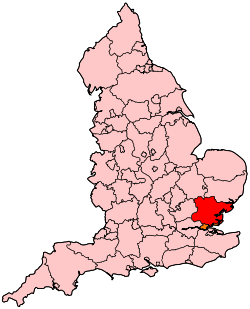Essex dialect

The Essex dialect is a traditional dialect mainly confined to the north and the east of Essex. It is similar to some forms of East Anglian English, including both the Suffolk and Norfolk dialects, but has its own peculiarities. With rapid urbanisation in the twentieth century, as well as the impact of the London overspill, Estuary English, a milder form of the London accent predominant largely along the Thames Estuary and thus the name, has become common, mainly in the southern portion of the county. As a result of the growing London influence, the usage of rural accents everywhere and the rural Essex dialect is now normally, but not always, confined to older generations in some of the areas affected and the dialect itself stands in a vulnerable state in those affected parts of the county. Elsewhere in Essex, the dialect and rural accent continues.
For example, in the coastal town of Harwich the Essex dialect is still common, even among the town's youth, and is a defining feature of the area. Harwich is pronounced as "arridge" in the local dialect, and in nearby Manningtree they pronounce Manningtree "mannintree", dropping the "g".
Many of the unique patterns of speech, as well as vocabulary were recorded in the nineteenth and early twentieth centuries[1][2] The Survey of English Dialects investigated 14 sites in Essex, most of which were in the rural north of the county and one of which was on Mersea Island. This unusually high number was the result of adding to the five sites that were originally investigated nine sites investigated by a Fulbright scholar after the original survey.[3]
An Essex Dialect Handbook has been published, and the Essex County Records office has recorded a CD of the sounds of Essex dialect speakers in an effort to preserve the dialect.[4][5][6]
Pronunciation
- The diphthong of [aɪ] which is common amongst East Anglian English and other predominantly English rural dialects, e.g. right > ‘roight’
- The shortening of certain elongated vowel sounds from [iː] to [ɪ], e.g. been > ‘bin’, seen > ‘sin’
- Yod-dropping is common, as in the Norfolk and Suffolk dialects
- Dropping of Ls, e.g. old > ‘owd’
- th-fronting, a feature now widespread in England, was found throughout Essex in the 1950s Survey of English Dialect.[7]
Characteristics
Frequently sounds are elided to allow the easy flow of speech; e.g.,
- Wonderful > 'wunnerful'
- Correctly > 'creckly'
- St Osyth > 'Toosie' (*meaning 'To Saint', as in the place, Saint Osyth*)
Grammar
Varying use of 'do', which is a common trait in Norfolk and Suffolk, is exhibited in the Essex dialect.
References
- ↑ Benham, Charles Edwin (23 October 2017). "Essex ballads and other poems". Colchester : Benham – via Internet Archive.
- ↑ Gepp, Edward. "A contribution to an Essex dialect dictionary". London G. Routledge – via Internet Archive.
- ↑ Craig Fees, The Imperilled Inheritance: dialect and folklife studies at the University of Leeds 1946-1962, Part 1: Harold Orton and the English Dialect Survey, page 20
- ↑ "Essex". John Nickalls Publications. Archived from the original on 30 October 2010.
- ↑ "Essex County Council". www.essexcc.gov.uk.
- ↑ "Archivists launch campaign to save Essex accent". 10 June 2009 – via www.telegraph.co.uk.
- ↑ Britain, David; Cheshire, Jenny, eds. (2003). "Dialect levelling and geographical diffusion in British English". Social Dialectology: In Honour of Peter Trudgill. Amsterdam: John Benjamins Publishing. p. 233.